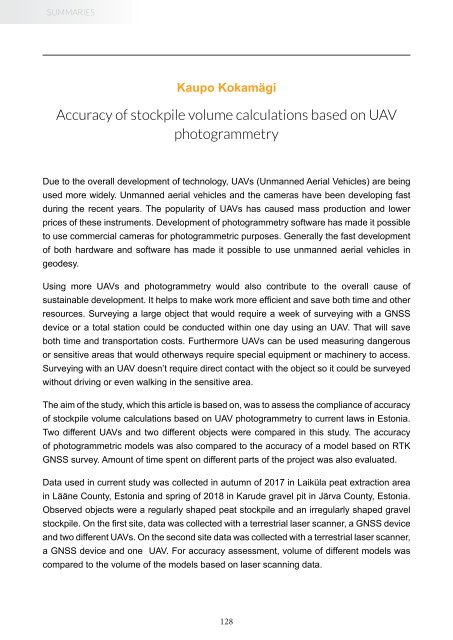TA_kogumik 2018-2019
Create successful ePaper yourself
Turn your PDF publications into a flip-book with our unique Google optimized e-Paper software.
SUMMARIES<br />
SUMMARIES<br />
Kaupo Kokamägi<br />
Accuracy of stockpile volume calculations based on UAV<br />
photogrammetry<br />
Due to the overall development of technology, UAVs (Unmanned Aerial Vehicles) are being<br />
used more widely. Unmanned aerial vehicles and the cameras have been developing fast<br />
during the recent years. The popularity of UAVs has caused mass production and lower<br />
prices of these instruments. Development of photogrammetry software has made it possible<br />
to use commercial cameras for photogrammetric purposes. Generally the fast development<br />
of both hardware and software has made it possible to use unmanned aerial vehicles in<br />
geodesy.<br />
Using more UAVs and photogrammetry would also contribute to the overall cause of<br />
sustainable development. It helps to make work more efficient and save both time and other<br />
resources. Surveying a large object that would require a week of surveying with a GNSS<br />
device or a total station could be conducted within one day using an UAV. That will save<br />
both time and transportation costs. Furthermore UAVs can be used measuring dangerous<br />
or sensitive areas that would otherways require special equipment or machinery to access.<br />
Surveying with an UAV doesn’t require direct contact with the object so it could be surveyed<br />
without driving or even walking in the sensitive area.<br />
The study found that the RMSE (Root Mean Square Error) of different photogrammetrical<br />
models of the Laiküla object (722,52 m3) was 14,31 m3 and the RMSE of different<br />
photogrammetrical models of the Karude object (674,04 m3) was 20,95 m3. Relative errors<br />
of all of the photogrammetrical models were under 4%, which is smaller than the allowed<br />
error of 12% in Estonia. Relative error of RTK GNSS model of Laiküla object was 5,81%<br />
and relative errors of different photogrammetric models of the same object were between<br />
0,70% and 3,19%. Respective errors of Karude object were 3,28% and 2,32% to 3,70%. It<br />
was found that the advantages of UAV photogrammetry become apparent as the size and<br />
complexity of the objects grow.<br />
Results show that using UAV photogrammetry to determine stockpile volumes is sufficiently<br />
accurate with both of the tested UAVs. Still, it is important that using UAVs for geodetic work<br />
would be done by trained professionals and all the legal requirements would be met. It was<br />
found that sufficient accuracy was also achieved without using the GCPs (Ground Control<br />
Points). However, using GCPs did increase the accuracy. Furthermore, using different types<br />
of GCPs had no impact to the accuracy of the volume. Still, using more GCPs also increased<br />
the accuracy.<br />
The aim of the study, which this article is based on, was to assess the compliance of accuracy<br />
of stockpile volume calculations based on UAV photogrammetry to current laws in Estonia.<br />
Two different UAVs and two different objects were compared in this study. The accuracy<br />
of photogrammetric models was also compared to the accuracy of a model based on RTK<br />
GNSS survey. Amount of time spent on different parts of the project was also evaluated.<br />
Data used in current study was collected in autumn of 2017 in Laiküla peat extraction area<br />
in Lääne County, Estonia and spring of <strong>2018</strong> in Karude gravel pit in Järva County, Estonia.<br />
Observed objects were a regularly shaped peat stockpile and an irregularly shaped gravel<br />
stockpile. On the first site, data was collected with a terrestrial laser scanner, a GNSS device<br />
and two different UAVs. On the second site data was collected with a terrestrial laser scanner,<br />
a GNSS device and one UAV. For accuracy assessment, volume of different models was<br />
compared to the volume of the models based on laser scanning data.<br />
128 129


